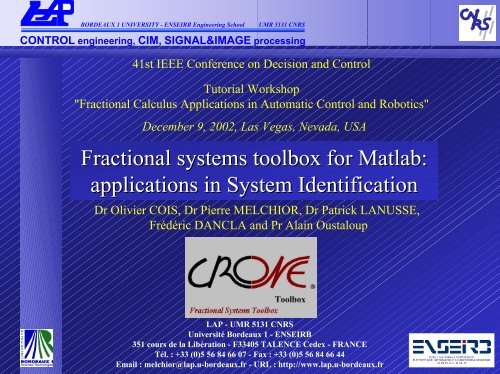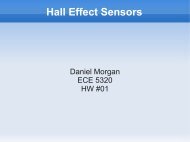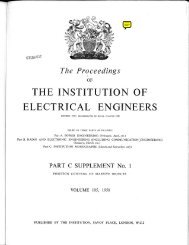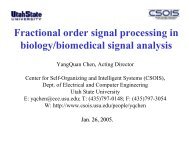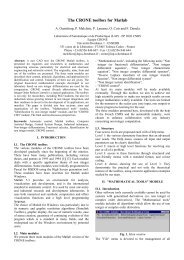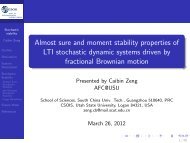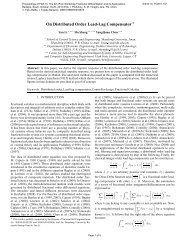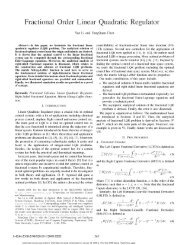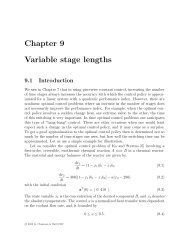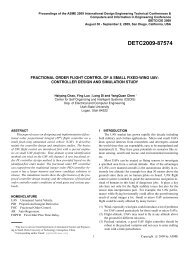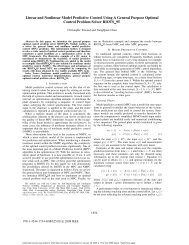Fractional System Toolbox for Matlab - mechatronics
Fractional System Toolbox for Matlab - mechatronics
Fractional System Toolbox for Matlab - mechatronics
Create successful ePaper yourself
Turn your PDF publications into a flip-book with our unique Google optimized e-Paper software.
BORDEAUX 1 UNIVERSITY - ENSEIRB Engineering School UMR 5131 CNRS<br />
CONTROL engineering, CIM, SIGNAL&IMAGE processing<br />
41st IEEE Conference on Decision and Control<br />
Tutorial Workshop<br />
"<strong>Fractional</strong> Calculus Applications in Automatic Control and Robotics"<br />
December 9, 2002, Las Vegas, Nevada, USA<br />
<strong>Fractional</strong> systems toolbox <strong>for</strong> <strong>Matlab</strong>: <strong>Matlab</strong><br />
applications in <strong>System</strong> Identification<br />
Dr Olivier COIS, Dr Pierre MELCHIOR, Dr Patrick LANUSSE,<br />
Frédéric DANCLA and Pr Alain Oustaloup<br />
LAP - UMR 5131 CNRS<br />
Université Bordeaux 1 - ENSEIRB<br />
351 cours de la Libération - F33405 TALENCE Cedex - FRANCE<br />
Tél. : +33 (0)5 56 84 66 07 - Fax : +33 (0)5 56 84 66 44<br />
Email : melchior@lap.u-bordeaux.fr - URL : http://www.lap.u-bordeaux.fr
A new CAD toolbox: toolbox:<br />
"The CRONE toolbox: toolbox<br />
<strong>Fractional</strong> <strong>System</strong>s <strong>Toolbox</strong>"<br />
<strong>Toolbox</strong><br />
• Applications<br />
• Concept<br />
The original theoretical mathematical concepts developed in<br />
our laboratory are based on fractional or non integer<br />
differentiation.<br />
CRONE control (French abbreviation <strong>for</strong> Non Integer Order<br />
Robust Control) and <strong>System</strong> Identification by fractional model<br />
are typical applications.<br />
•Aims<br />
•Facilitate transfer of concepts to :<br />
- engineers, researchers in mathematics and engineering sciences,<br />
- universities,<br />
- industrials.<br />
•Make our research results widely available and develop international relations<br />
• Identification & Robust control (electromechanical, thermal, pneumatic,<br />
hydraulic systems, …)<br />
• Electronic (filter synthesis),<br />
• Path planning : Path description (cutting table) & Path tracking<br />
• Signal and image processing, ...
1. <strong>System</strong> Identification<br />
Content<br />
A new tool <strong>for</strong> mathematical models of physical systems<br />
Principles of parameter estimation methods<br />
<strong>Matlab</strong> <strong>Toolbox</strong><br />
Application example
A new tool <strong>for</strong> mathematical models<br />
of physical systems<br />
What is exactly a fractional derivative ?<br />
⎛<br />
⎜<br />
⎝<br />
n<br />
d ⎞<br />
⎟ f<br />
dt⎠<br />
() t<br />
d n<br />
⎛ ⎞<br />
⎜ ⎟<br />
⎝ dt ⎠<br />
f<br />
() t<br />
Mathematical viewpoint<br />
Time domain Operational domain<br />
• Riemann Liouville definition<br />
∆<br />
=<br />
Γ<br />
( m − n)<br />
• Complicated <strong>for</strong>mula<br />
1<br />
m<br />
⎛ d ⎞ ⎛ t<br />
⎜ ⎟ ⎜<br />
⎝ dt⎠<br />
⎜∫0<br />
−<br />
⎝<br />
Laplace trans<strong>for</strong>m<br />
( )<br />
( ) ( ) ⎟ f τ ⎞<br />
dτ<br />
−<br />
1−<br />
m n<br />
t τ<br />
• Global operator: takes into account<br />
all the values of function f(t)<br />
⎠<br />
Magnitude (dB)<br />
Phase (deg)<br />
-50<br />
s F()<br />
s<br />
n<br />
• Expression simpler than<br />
in the time domain<br />
50<br />
0<br />
200<br />
10 -1<br />
0<br />
-200<br />
10 -1<br />
n=-1.5<br />
n=-1<br />
n=-0.5<br />
n=0<br />
n=0.5<br />
n=1<br />
n=1.5<br />
Bode diagrams<br />
10 0<br />
Frequency (rad/s)<br />
10 0<br />
Frequency (rad/s)<br />
10 1<br />
10 1
A new tool <strong>for</strong> mathematical models<br />
of physical systems<br />
<strong>Fractional</strong> differential equation<br />
n<br />
⎛ d ⎞<br />
a0⎜<br />
⎟<br />
⎝ dt<br />
⎠<br />
a0<br />
y<br />
n<br />
⎛ d ⎞<br />
1⎜<br />
⎟<br />
⎝ dt<br />
⎠<br />
a1<br />
n<br />
⎛ d ⎞<br />
L⎜<br />
⎟<br />
⎝ dt<br />
⎠<br />
aL<br />
n<br />
⎛ d ⎞<br />
0⎜<br />
⎟<br />
⎝ dt<br />
⎠<br />
n<br />
⎛ d ⎞<br />
1⎜<br />
⎟<br />
⎝ dt<br />
⎠<br />
n<br />
⎛ d ⎞<br />
M ⎜ ⎟<br />
⎝ dt<br />
⎠<br />
() t + a y()<br />
t + ... + a y()<br />
t = b u()<br />
t + b u()<br />
t + ... + b u()<br />
t<br />
<strong>Fractional</strong> state space representation<br />
⎧<br />
⎛ ⎞<br />
⎪⎜<br />
⎟<br />
⎨⎝<br />
dt<br />
⎠<br />
⎪<br />
⎩y<br />
d n<br />
x<br />
() t = A x()<br />
t + B u()<br />
t<br />
() t = C x()<br />
t + D u()<br />
t<br />
Mathematical viewpoint<br />
b0<br />
b1<br />
•Modal decomposition<br />
•Output analytical expression<br />
•Stability properties<br />
bM
A new tool <strong>for</strong> mathematical models<br />
of physical systems<br />
Thermal system studies<br />
Semi-infinite medium<br />
• Diffusive equation<br />
→ x = 0<br />
⎛ d ⎞<br />
⎜ ⎟<br />
⎝ dt<br />
⎠<br />
0.<br />
5<br />
→ x > 0 : series expansion<br />
⎛<br />
⎜<br />
⎝<br />
d<br />
dt<br />
⎞<br />
⎟<br />
⎠<br />
0<br />
. 5<br />
T<br />
T<br />
∂T<br />
∂t<br />
1<br />
λ ρ C<br />
( 0,<br />
t)<br />
= φ()<br />
t<br />
1<br />
λ ρ C<br />
∑ ∞<br />
n=<br />
0<br />
( x,<br />
t)<br />
=<br />
c φ()<br />
t<br />
p<br />
( x,<br />
t)<br />
= c ( x,<br />
t)<br />
n<br />
∂<br />
2<br />
∂x<br />
T<br />
p<br />
2<br />
⎛ d ⎞<br />
⎜ ⎟<br />
⎝ dt<br />
⎠<br />
n<br />
2<br />
Physical viewpoint<br />
φ(t)<br />
0<br />
T(x,t)<br />
Semi-infinite medium<br />
x
A new tool <strong>for</strong> mathematical models<br />
of physical systems<br />
T<br />
Other geometries : fractional differential equation<br />
0.<br />
5<br />
1<br />
0.<br />
5M<br />
0.<br />
5 N<br />
() t + a D T () t + a D T () t + ... + a D T () t = b φ()<br />
t + b D φ()<br />
t + ... + b D φ()<br />
t<br />
1<br />
2<br />
M<br />
Physical viewpoint<br />
Studies of various geometries (cylindrical, spherical …) show that fractional<br />
differential equations, with differentiation orders being multiples of 0.5, permit better<br />
approximations of analytical solutions than classical differential equations<br />
The result can be extended to all the physical systems governed by<br />
- the diffusive partial differential equation (electrochemical systems,<br />
electromagnetic systems)<br />
- the Telegraphist partial differential equation (long transmission cables…)<br />
Preliminary conclusion: fractional differentiation is an efficient tool<br />
<strong>for</strong> modeling some real physical systems<br />
0<br />
1<br />
0.<br />
5<br />
N
1.5<br />
1<br />
0.5<br />
0<br />
y<br />
n<br />
⎛ d ⎞<br />
1⎜<br />
⎟<br />
⎝ dt<br />
⎠<br />
a1<br />
<strong>System</strong> Identification<br />
Goal: establish a mathematical model capable of reproducing the system's<br />
physical behavior as faithfully as possible from a series of observations<br />
u ( t)<br />
y(<br />
t)<br />
Real physical <strong>System</strong><br />
0 20 40 60 80<br />
Parameter estimation method<br />
n<br />
⎛ d ⎞<br />
L⎜<br />
⎟<br />
⎝ dt<br />
⎠<br />
aL<br />
n<br />
⎛ d ⎞<br />
0⎜<br />
⎟<br />
⎝ dt<br />
⎠<br />
n<br />
⎛ d ⎞<br />
1⎜<br />
⎟<br />
⎝ dt<br />
⎠<br />
n<br />
⎛ d ⎞<br />
M ⎜ ⎟<br />
⎝ dt<br />
⎠<br />
() t + a y()<br />
t + ... + a y()<br />
t = b u()<br />
t + b u()<br />
t + ... + b u()<br />
t<br />
b0<br />
b1<br />
3<br />
2<br />
1<br />
0<br />
-1<br />
0 20 40 60 80<br />
bM
<strong>System</strong> Identification:<br />
parameter estimation methods<br />
<strong>for</strong> fractional models<br />
y<br />
n<br />
⎛ d ⎞<br />
1⎜<br />
⎟<br />
⎝ dt<br />
⎠<br />
a1<br />
linearity with respect to coefficients<br />
non-linearity with respect to differentiation orders<br />
2 types of estimation methods<br />
Only coefficients are estimated<br />
orders are fixed by the user<br />
Equation error method<br />
n<br />
⎛ d ⎞<br />
L⎜<br />
⎟<br />
⎝ dt<br />
⎠<br />
linear optimisation techniques<br />
aL<br />
Least Square, Instrumental Variable...<br />
<strong>Fractional</strong> models<br />
n<br />
⎛ d ⎞<br />
0⎜<br />
⎟<br />
⎝ dt<br />
⎠<br />
n<br />
⎛ d ⎞<br />
M ⎜ ⎟<br />
⎝ dt<br />
⎠<br />
() t + a y()<br />
t + ... + a y()<br />
t = b u()<br />
t + ... + b u()<br />
t<br />
b0<br />
Both orders and coefficients<br />
are estimated<br />
Output error method<br />
non-linear optimisation techniques<br />
Gradient, Marquardt ...<br />
bM
<strong>Matlab</strong> <strong>Toolbox</strong>
Application example<br />
Application Field: Machining by turning<br />
The efficency of a machining depends<br />
on the heat flux through the tool<br />
It cannot be measured directly<br />
during machining<br />
Tools Temperature, Flux ?<br />
How to estimate the heat flux through the tool during machining
2 stages<br />
Strategy<br />
Heat surface<br />
Thermocouple<br />
T<br />
Insert tool<br />
Sensor<br />
Tool holder<br />
1. Be<strong>for</strong>e machining: Identify the thermal dynamic behavior between<br />
- heat flux through the tool<br />
- temperature close to the tip of the tool<br />
2. During machining: Estimate the heat flux through the tool using:<br />
- the identified thermal model<br />
- temperature measurments close to the tip of the tool<br />
q
T<br />
Identification of the thermal dynamic behavior of the tool<br />
Heat resistor<br />
Model structure choice<br />
thermocouple embeded in the tool<br />
Heat surface<br />
q<br />
Thermocouple<br />
T<br />
Thermal system <strong>Fractional</strong> model<br />
0.<br />
5<br />
1<br />
0.<br />
5M<br />
Insert tool<br />
Sensor<br />
Tool holder<br />
0.<br />
5 N<br />
() t + a D T () t + a D T () t + ... + a D T () t = b φ()<br />
t + b D φ()<br />
t + ... + b D φ()<br />
t<br />
1<br />
2<br />
M<br />
0<br />
1<br />
0.<br />
5<br />
N
T<br />
Power supply<br />
1.5<br />
1<br />
0.5<br />
Identification of the thermal dynamic behavior of the tool<br />
0<br />
0 20 40 60 80<br />
Thermocouple<br />
3<br />
2<br />
1<br />
0<br />
-1<br />
0 20 40 60 80<br />
Heat flux Temperature<br />
0.<br />
5<br />
1<br />
0.<br />
5M<br />
0.<br />
5 N<br />
() t + a D T () t + a D T () t + ... + a D T () t = b φ()<br />
t + b D φ()<br />
t + ... + b D φ()<br />
t<br />
1<br />
2<br />
Parameter estimation method<br />
M<br />
0<br />
1<br />
0.<br />
5<br />
N
Identification of the thermal dynamic behavior of the tool<br />
Data acquisistion : estimation and validation data (Ts=0.1s)
Identification of the thermal dynamic behavior of the tool<br />
Parameter estimation : 5 parameters<br />
0.<br />
5<br />
1<br />
() t + 10. 90 D T () t −1.<br />
04 D T () t + 39.<br />
81D<br />
T () t = 6.<br />
22φ()<br />
t −1.<br />
65D<br />
() t<br />
T φ<br />
1.<br />
5<br />
0.<br />
5
Identification du comportement thermique de l'outil<br />
Model validation
Conclusion (Syst ( Syst. . Ident.) Ident.)<br />
A further class of mathematical models, called fractional models, has been<br />
developed and analyzed (stability theorem, output analytical expression…)<br />
Various estimation methods of fractional models have been developed and<br />
applied to the identification of real systems<br />
A <strong>Matlab</strong> <strong>Toolbox</strong> has been developed<br />
<strong>Fractional</strong> differentiation is shown to be an efficient tool <strong>for</strong><br />
modeling certain real systems, using few parameters<br />
Application to the identification of electro-chemical systems (batteries)


